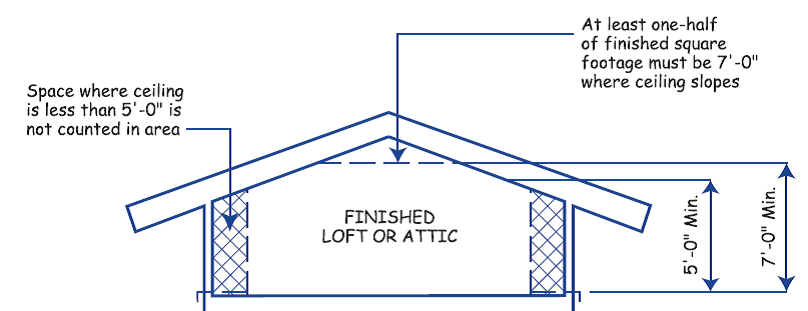Determining the living area of a home can be somewhat challenging in real estate. Currently, there is not one nationally-recognized standard for measurement that every appraiser must follow. This can create challenges when measuring a home to list for sale, or when measuring for the appraisal after the home has a contract on it. While there is not a single set of rules that every appraiser must follow, one standard that is widely known and used is the American National Standard Institute (ANSI). Additionally, Fannie Mae and FHA each have specific guidelines that appraisers are required to follow for loans that go through those agencies.
While there is no one standard that appraisers must follow when it comes to measuring single-family homes, there is one standard that is well know; the American National Institute (ANSI).
ANSI
ANSI has several guidelines for what is considered living area and what is not. One area that these guidelines cover is ceiling height, which often creates confusion when it comes to calculating gross living area. ANSI says that any part of a room that has less than 5 feet from the floor to the ceiling is NOT included in the living area. It also says that for a room to be included in the gross living area, at least half of the space in the room must have a ceiling height of at least 7 feet. This is important when measuring homes that have a second or third level. There are instances where the ceiling can be sloped in some areas with a height of less than 5 feet. It is important that the correct measurements are taken so that an accurate gross living area can be calculated. Ceiling height can also be an issue in A-frame houses. Since the exterior walls have a slope all the way (or almost all the way) to the ground level, appraisers must be careful when measuring A-frame homes.
The following is an illustration from the ANSI standards to help clarify which areas can be included in the GLA. (Figure 4 from The American National Standard For Single-Family Residential Buildings)

Another area that ANSI guidelines covers is the stairway. ANSI says that, “the area of both stair treads and landings proceeding to the floor below is included in the finished area of the floor from which the stairs descend, not to exceed the area of the opening in the floor.” This means that if you have a home with a second level, the stairs are included in the gross living area of the second floor as long as the area of the stairs does not exceed the opening above. ANSI also goes on to say that, “areas beneath stairs are included in the finished square footage regardless of the distance between the stairs and the floor below or of the degree of finish of that area.” Although the area beneath the stairs may be less than five feet, ANSI says that it is included in the square footage of the space below the stairs.
FHA
If a loan is insured by FHA, appraisers must comply with their standards. One of these standards specifies how living area is measured. According to the FHA guidelines, the gross living area (GLA) is defined as “the total area of finished, above-grade residential space calculated by measuring the outside perimeter of the structure. It includes only finished, habitable, above-grade living space.” FHA also says that the appraiser must:
- identify non-contiguous living area and analyze its effect on functional utility;
- ensure that finished basements and unfinished attic areas are not included in the total GLA; and
- use the same measurement techniques for the subject and comparable sales, and report the building dimensions in a consistent manner.
According to FHA, it is important that only above-grade finished areas are included in the GLA. Also, finished areas not accessible directly from the main dwelling are not to be included in the GLA; i.e., a bonus room above the garage that can only be accessed through the garage. While basements are not typically part of homes in South Louisiana, it is important for appraisers in other areas of the country to be aware of this guideline.
FHA also talks about “Additions and Converted Spaces.” For additions or converted space to be considered living area, it must be:
- accessible from the interior of the main dwelling in a functional manner;
- has a permanent and sufficient heat source; and
- was built in keeping with the design, appeal, and quality of construction of the main dwelling.
It is important that the addition or conversion meet all three requirements. If any one requirement is missing, then it is not considered part of the living area. For example, an attic above a garage that is finished as the rest of the dwelling is not part of the gross living area if you must walk through the garage to access the conversion. For these such additions or conversions that do not meet the criteria, the appraiser must analyze the effects of the area and account for it in the appraisal.
Fannie Mae
Fannie Mae also has their own guidelines on what constitutes living area. Their guidelines state that when calculating living area, appraisers must use exterior building measurements per floor for above-grade areas. They also state that living area includes only finished areas that are above grade. Areas that are finished, but not included as living area, must be considered by the appraiser by analyzing the market to determine its effect on value.
In addition to these guidelines, there are many more rules for calculating the living square footage of residential properties. To get the most accurate measurement of your home, be sure to contact a qualified appraiser who is knowledgeable of the rules and guidelines that must be followed. If I can assist you in your measurements, you can contact me by email at Lduple4@gmail.com or on my phone at 337.254.2215.
